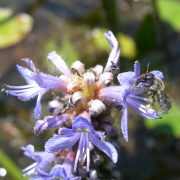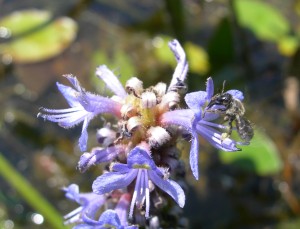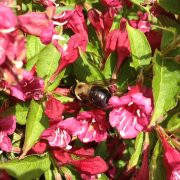By Crystal Ernst, PhD Candidate (McGill University)
Since I finally submitted my manuscript to a journal (YAY!), I’ve been tying up the little loose ends remaining at the end of the project. You know: organizing the useful data and image files, tossing the files marked “MESSING_AROUND_WITH_DATA_v.29), tidying up my R code, and, perhaps most importantly, curating my specimens.
I’m not going to go into too much detail about the project here (I’m saving that for another post). I will say, though, that the work I just completed includes just over 2,600 beetles from a single location in Nunavut (Kugluktuk, where I spent my entire first field season).
Two major aspects of the physical work (as opposed to the thinking, reading and writing) involved in an ecological/entomological project such as this one are the pinning and the identifications. Some of the tasks are a bit tedious (cutting labels; entering data; gluing over 800 specimens of the same tiny, plain black ground beetle to paper points), and some of them are thrilling (finally getting over the “hump” of the morphological learning curve and feeling good and confident when working with your keys; having experts tell you “Yep, you got those all right”; discovering rare species or new regional species records). In the end, in addition to the published (*knocks on wood*) paper, you have boxes or drawers full of specimens.
The specimens are gold. (Read this post by Dr. Terry Wheeler to understand why.)
Unfortunately, they don’t always get treated as such.
In the two-ish years that I’ve been working in my lab, we’ve had two major “lab clean-up days”. The first managed to get rid of a lot of clutter (old papers, broken apparatus, random crap). The second involved going through the “stuff” that was eating up all the most valuable storage space: specimens. Years and years worth of graduate and undergraduate projects’ specimens, stashed in freezers, boxes, bags and vials of all shapes and sizes.
Some things were in good shape (pinned well, or in clear ethanol). Other things were, well, downright nasty: gooey beetles in sludgy brown ethanol, dried up bits of moth wings in plastic containers, and a little bit of “what in the name of pearl is growing on that agar plate???” in the fridge.
None of these items were kept – their value as useful specimens was nil. So, the physical representation of some student’s work – probably months or years worth of work – was tossed in the trash.
Others, happily, were tucked back into drawers and cupboards, because someone had taken the time to ensure the specimens were well-preserved.
However, even many of these were suffering from a serious issue: bad labels.
Allow me to illustrate the point. This is a bad label:
 This is also a bad label:
This is also a bad label:

The first, you’ll note, is written in ballpoint pen (which fades) on a torn piece of notebook paper and contains almost no information. The second, although it looks fancier and perhaps more sciencey, is just as bad: it contains a cryptic code that is useful only to the bearer of the lab notebook in which said code has been written down. Or, perhaps the code is completely intelligible to the researcher who developed it, but the key to it exists only in his or her head.
To everyone else, it is meaningless. Neither of these labels indicate who collected the specimen, where, when, or how. And we all know what happens in labs: upon completion of their degrees, students move on, email addresses change, notebooks are misplaced, data files are not backed up. The labels’ codes can never be broken, and the scientific value of the specimens – *poof*.
While there’s nothing wrong, in theory, with using labels like these temporarily (although there is always a risk that they will be misinterpreted or misunderstood after a little while, even by the person who wrote them), they are absolutely useless as permanent records.
These are good labels:

These labels, properly affixed to a specimen, provide clear and universally understood information. One provides the location, including GPS coordinates, a method of collection, a date, the name of the collector(s). The information that goes on this label can vary a bit (it may include information about the habitat or host plant, for example), but those are the basic requirements. The smaller label is typically affixed on the pin below the first, and contains the specimen’s scientific name and the name of the person who identified it (it is the “det. label”, i.e., “determined by”). These labels, and therefore the specimen with which they are associated, will remain useful for decades, even centuries.
I am totally guilty of both of the offenses I just explained (the gooky vials of nastiness and the bad labels). For my undergraduate honors project, I identified close to 8000 spiders, mites and insects to the Family level – it was hundreds of hours of microscope work. Then I stuffed all those specimens back into vials with cryptic little codes, like V-1-F(!), hand-written on STICKERS(!), which I placed on the LIDS(!) and not even in the vials themselves(!). Oh, and I’ve long since lost the notebook that contained my decoder key(!). THIS IS ALL SO BAD. I have no doubt that those boxes of vials, which I once prized so highly and felt such pride for, have been unceremoniously tossed in the trash by my former advisor.
Well, I’ve learned from my mistakes, and from working with museum and other collection specimens. I now understand that each specimen is deserving of respect – it’s the original data after all – and that means it should be properly preserved, and labelled.
So.
Last week I spent a great deal of time, as I said, tying up my loose ends. The last thing I needed to do was remove my cryptic labels (the second in the series up there is an actual example of one of my own “secret code” labels) and replace them with proper ones, sorting and tidying up the collection in the process. The end result?
This:

Frankly, it’s a thing of beauty. It’s also enormously scientifically valuable. These specimens will be deposited in various nationally-important collections and museums, like the CNC.

As a matter of fact, just last week I was at the CNC, and I saw specimens bearing the name of the last person to do a comprehensive survey of the insects in Kugluktuk, back in 1955. That tiny but so-important label suddenly made me feel connected to the man who, almost 60 years earlier, had stood on the same stretch of tundra as me, holding and perhaps delighting in the very specimen that I held in my own hand.

Giving my specimens the respect they deserve is worth it, not only for the scientific value, but also because perhaps, 60 years from now, another grad student will discover my name on a specimen’s det. label. Perhaps she, too, will feel that same wondrous sense of connection to the the greater scheme of scientific discovery…

____________________________
Original post at: http://thebuggeek.com/2012/06/25/respect-your-specimens/





























